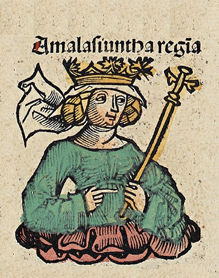Amalasuntha
| Amalasuntha | |
|---|---|

Amalasiuntha regina – woodcut from the Nuremberg Chronicle (1493)
|
|
| Born | c. 495 |
| Died | 535 (aged 39–40) |
| Spouse | Traguilla Eutharic |
| Issue |
Athalaric Matasuntha |
| Father | Theoderic the Great |
| Mother | Audofleda |
Amalasuntha (also known as Amalasuentha, Amalaswintha, Amalasuintha, Amalswinthe or Amalasontha) (c. 495 – 30 April 534/535) was a regent of the Ostrogoths from 526 to 534. She was the youngest daughter of Theoderic the Great, and firmly believed in the upholding of Roman virtues and values. She is most well known for her diplomatic relationship with Justinian I, who would invade Italy in response to her assassination.
Amalasuntha was married in 515 to Eutharic (c. 480 – 522), an Ostrogoth noble of the old Amal line, who had previously been living in Visigothic Hispania, son of Widerich (born c. 450), grandson of Berismund (born c. 410), and great-grandson of Thorismund (died after 400), King of the Ostrogoths c. 400. It was important to Amalasuntha's father, Theoderic the Great, that she marry into a legitimate royal family, lest her own family's legitimacy be questioned.
She was very much an intellectual, and was well known for her extensive knowledge, which included the study of three languages, Latin, Greek and Gothic. In addition, she was a student of philosophy, said to bear the wisdom of Solomon. Amalasuntha was also described in her day as possessing all of the central Roman virtues expected of a noble woman, like happiness, fertility, and patience, though more emphasis was placed on her virtues within the political realm versus the feminine, something that separates her from other Ostrogoth princesses.
Her husband died, apparently in the early years of her marriage, leaving her with two children, Athalaric and Matasuntha (c. 517 – after 550), wife c. 550 of Germanus. On the death of her father in 526, her son succeeded him at the age of ten, but she held the power as regent for her son. Her tremendous influence in her position as regent can be seen in a diptych she appears in alongside her son, Athalaric, in 530. Deeply imbued with the old Roman culture, she gave to that son's education a more refined and literary turn than suited the ideas of her Gothic subjects. Conscious of her unpopularity she banished, and afterwards put to death, three Gothic nobles whom she suspected of intriguing against her rule, and at the same time opened negotiations with the emperor Justinian I with the view of removing herself and the Gothic treasure to Constantinople. Her son's death in 534 made little change in the posture of affairs.
...
Wikipedia
